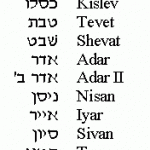Two Adars – Ask the Rabbi
Q. Why do we have two months called Adar?
 A. An ordinary year has only one Adar. In a leap year there are two – Adar Rishon (Adar I) and Adar Sheni (Adar II).
A. An ordinary year has only one Adar. In a leap year there are two – Adar Rishon (Adar I) and Adar Sheni (Adar II).
Leap years, seven times in every 19 years, ensure that the Jewish lunar calendar is able to tally with the solar calendar.
Since there is normally a discrepancy of about 11 days between them, without leap years the 11 days would mount up, so that Pesach, for example, would move from one season to another, whereas the Torah requires (Ex. 13:4, 23:15, 34:18; Deut. 16:1) that it be a spring (aviv) festival (in the southern hemisphere it is in the autumn). The additional month re-connects the two types of years.
All this comes at the end of the list of months, so that whereas an ordinary year ends with one Adar, a leap year ends with two.
This creates a further question – since Purim is in Adar, in which Adar does it fall in a leap year?
The answer is Adar II, which is closer to Nisan, the month of Pesach, than Adar I. Why Purim and Pesach should be so close is because both are festivals of redemption, the one concerned with the redemption of the Jews of Persia and the other the whole of the Israelite people.
What do we do on 14 Adar I, which might feel slighted to be superseded in favour of 14 Adar II? We call it Purim Katan (“the little Purim”) and we have a modest celebration by leaving out the supplicatory prayers that day and, according to the Rema (Orach Chayyim 697), we should also have some sort of festive meal.



